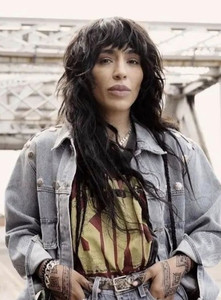Harmony of the portrait zone or Who suits bangs
- Sophia Kathermes

- Oct 5
- 4 min read
Updated: Oct 7
On the influence of compositional errors on facial perception
The limits of what is accessible to each individual appearance are different - this fact can be frustrating, but in essence it is simply a given that one must become friends with in order to be able to use it as a solid support for further creativity.

The boundaries are clearer and narrower the more categorically and vividly the stylistic components are expressed - primarily, color and composition.
And it’s not just a matter of the physical interaction between appearance and frame, but also the psychological effect that results from the presence or absence of harmony between them.
Today I'd like to talk about composition in portrait photography, which has a profound impact on how we perceive a person. I'll be assisted by singer Loreen, model Olivia Vinten, and random photos of works by beauty industry professionals.
So, hair
A sign of health, one of the symbols of beauty, perceived by many people as wealth. Can they not wear makeup?
They can, and it's not just a matter of quality and structure, but also the shape they create and quantity (or more precisely, area, visual mass). What's interesting is that a lack of volume is often a struggle, even though it can be completely useless (or even harmful) to the image.
Both large and small volumes can be equally a problem and a gift - it all depends on the "needs of the person".
Proportion and the principle of similarity are key points in everything that concerns composition in style.
Otherwise, the elements will begin to clash and "exaggerate" each other. In rare exceptions and in skilled hands, this can be beneficial, adding character to the image, but it's important to remember that animators exploit pronounced disharmony to create negative or comical characters.
So, what can I notice when looking at the girls? My gaze is drawn to the disproportion—the faces are too big and too small.
Lorin's features (left) are extremely expressive, large, and monolithic. The size of her features leaves very little free space in the compositional center. Her haircut, while lush, is too compact (based on a circle).
Olivia's features (on the right), on the contrary, are very delicate and compact, taking up little space on the face and are completely lost against the backdrop of such a luxurious mane.
Let's try to swap them around while maintaining the proportions of the head?
The compositional centers of the faces against the visual perception of the hairstyles' shapes illustrate the principle of proportionality well. In more appropriate versions, the features do not appear excessive or insufficient:
What do Lorin's monolithic and expressive features require?
First of all, bangs are certainly not recommended for her, as they would reduce the already cramped area of her face.
The second point is that the wide, dense and streamlined "strokes" of the exterior contradict the fine carbon detail.
It needs scope, integrity and large, non-sharp details to prevent the expressive features from appearing coarse or puffy.

In general, layered haircuts like the "shaggy" that have become popular in recent years generally suit faces with similarly fine, small, and delicate detailing. The example below also shows, in my opinion, the damaging effect such a cut can have on a woman's expressive and smooth features:
A reduction in facial area, the replacement of an elongated shape with a compact one, a variegated texture instead of the required smooth one, and as a result, a fresh, sensual girl has turned into a tired woman in a carnival wig.
This is a comment on the psychological impact of errors in working with linearity: strong, bright faces against a background of thin and light lines do not become lighter - they seem weaker, they lose support.
Let's talk about delicacy.
For Olivia, who has very compact and delicate features, the less visual bulk the hairstyle provides, the better. Bangs or neat, thin strands framing her face are highly recommended. Or would be, if she weren't a model, as the world of modeling differs from everyday life in its fundamentally different attitude toward all kinds of disproportions.
However, if bangs/strands clash with other style elements (such as a image type or archetype), there are other ways to reduce the volume contrast: a short haircut or a combed-back hairstyle. In Olivia's case, both should create a rounded shape without being too elongated or backcombed.

Small, fine-lined details will also suit her according to the rule of similarity.
Neat features require neat details.
I have an additional example for this thesis, but with hair of a different kind:

Eyebrows
Another of my immense pains (in addition to the one when girls dye their noble ash-blond hair, calling it "mousy") is the relentless pursuit of expressive eyebrows.
Sable eyebrows, like a full head of hair, are beautiful in a vacuum, but when they don't match the features, they also create the opposite effect to the desired one:
Too thin/pale eyebrows with wide, expressive features create a weak and sickly appearance.
Too thick eyebrows with soft, neat features (see example) - do not give the image strength and brightness, but rather coarseness, negative harshness and discontent.
Every style story is unique, and rules are meant to be broken, but I advocate that these rules should first be learned and tested—perhaps a long and agonizing search for your own case in the list of exceptions won't be necessary.
That's all I have for today, dear participants. I hope you find these observations useful. ♥
Peace between the outer and inner to each and everyone!
Thank you for your trust, and until next time.!





















Comments